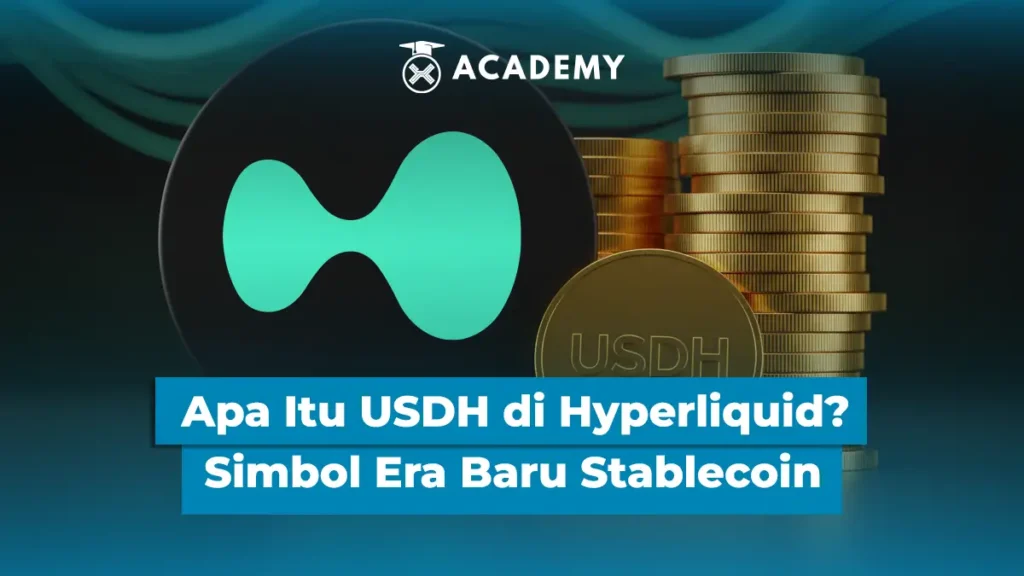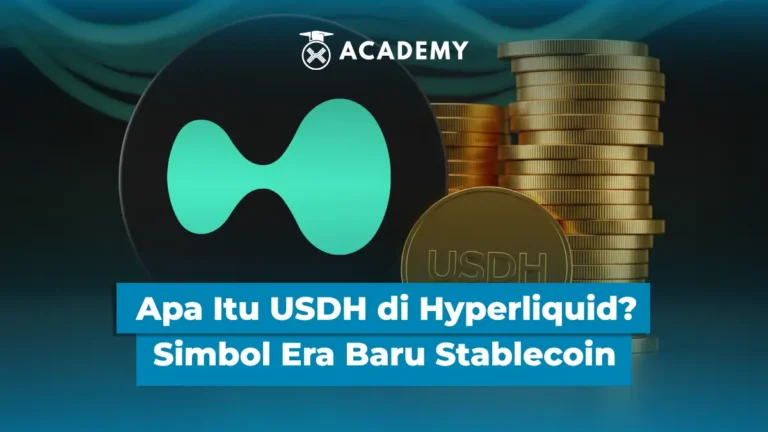The DeFi world has been heating up since Hyperliquid officially released a new stablecoin called USDH. Its presence immediately attracted attention as it was said to be ready to challenge the dominance of USDC and USDT in the DeFi market.
This article will discuss in more detail what USDH is, who developed it, how it differs from other stablecoins, and its potential and risks for users.
What is USDH?

USDH is a stablecoin pegged 1:1 to the US dollar and designed to be the backbone of the on-chain financial ecosystem. Originally developed by Native Markets through the Hubble Protocol on the Solana network, USDH is now officially a native stablecoin on the Hyperliquid network (HyperEVM), making it a direct part of the platform’s core infrastructure.
In the Hyperliquid DEX ecosystem, USDH serves as the primary collateral for activities such as margin trading, liquidity provision, and transaction settlement.
Through this stablecoin, Hyperliquid strives to create a fully on-chain financial system, independent of traditional financial institutions, while strengthening the foundation of a more independent and transparent DeFi ecosystem.
The Origins and Development of USDH
The initial version of USDH was first developed through the Hubble Protocol on the Solana network as an over-collateralized stablecoin, meaning a token whose value is backed by over-collateralized crypto assets to maintain its stability against the US dollar.
Entering 2025, the Hyperliquid Foundation took a major step by releasing the latest version of USDH on the HyperEVM network.
This milestone marked USDH’s transformation from an experimental project on Solana to a native stablecoin within the Hyperliquid ecosystem.
This launch also sparked new competition in the DeFi space, particularly with major stablecoin issuers like Paxos, Frax Finance, and Native Markets.
They now have to compete with Hyperliquid’s stablecoin model, which offers a fully on-chain system and direct integration into decentralized derivatives exchanges.
USDH now plays a strategic role in Hyperliquid’s plans to expand its DeFi ecosystem.
This stablecoin is not just a transaction tool, but also an economic foundation that strengthens liquidity, supports trading activity, and adds value to the Hyperliquid ecosystem token, HYPE.
Characteristics and Features of USDH
USDH is a stablecoin pegged 1:1 to the US dollar (USD), ensuring price stability in every transaction in the Hyperliquid ecosystem.
Unlike conventional stablecoins that rely on fiat reserves in banks, USDH is crypto-backed, meaning each token is collateralized by crypto assets securely stored in on-chain smart contracts.
All operations run entirely on the Hyperliquid network (HyperEVM) without the involvement of a centralized custodian, allowing users to retain full control over their assets.
In practice, USDH is used for various activities on the Hyperliquid DEX, such as margin trading, lending, and even settling transactions between users.
Another advantage of USDH is its high level of transparency, as all collateral and transaction data can be publicly verified on the blockchain.
With these characteristics, USDH is a stablecoin that is not only stable but also completely open and compliant with the principles of decentralized finance.
Why USDH Is Important in the DeFi World
The introduction of USDH is a crucial step for Hyperliquid in achieving independence from centralized stablecoins like USDC and USDT.
By having its own stablecoin, Hyperliquid can independently manage internal liquidity without relying on external issuers, thus enhancing control over its ecosystem.
Through USDH, Hyperliquid also strengthens its position as a hub for on-chain liquidity in the DeFi world.
This stablecoin not only functions as a medium of exchange but is also a key element in derivatives trading, lending, and various financial activities on the HyperEVM network.
Furthermore, USDH is driving the DeFi world towards greater transparency, decentralization, and efficiency.
With a fully on-chain system, every transaction and reserve is publicly verifiable, creating greater trust among users.
In addition to strengthening the foundation of the Hyperliquid ecosystem, USDH also opens up new opportunities for other DeFi projects to build products and services based on this stablecoin.
In this way, USDH not only expands Hyperliquid’s reach but also becomes a crucial pillar in the development of a more open and independent DeFi ecosystem.
How USDH Differs from Other Stablecoins
Unlike popular stablecoins like USDC and USDT, which are backed by fiat assets and managed by centralized entities, USDH offers a completely decentralized approach.
Its value remains pegged 1:1 to the US dollar, but its entire collateral comes from crypto assets held directly in on-chain smart contracts, without the involvement of traditional financial institutions.
Meanwhile, stablecoins like DAI already use a crypto-based collateral system, but some of their reserves still rely on fiat stablecoins like USDC.
This is where USDH differs: it is fully crypto-backed and native to the Hyperliquid network (HyperEVM), making it independent of any external issuer.
By combining the stability of the US dollar with complete independence from the on-chain network, USDH is a new, evolutionary form of stablecoin that is more transparent, independent, and compliant with the core principles of decentralized finance (DeFi).
Risks and Challenges of Using USDH
Despite offering transparency and on-chain independence, USDH still carries a number of risks that users should be aware of. One of these is the volatility of the collateral.
Because USDH is backed by crypto assets, fluctuations in the collateral’s price can impact its value stability and potentially disrupt its 1:1 peg to the US dollar if not carefully managed.
Furthermore, there are smart contract risks, namely the possibility of bugs, security vulnerabilities, or technical exploits that could be exploited by irresponsible parties.
Although the Hyperliquid (HyperEVM) network system is designed with a high level of security, such threats remain a major concern in the DeFi world.
Another challenge is limited liquidity. As a new stablecoin, USDH’s adoption is not yet as high as USDC or USDT, so its trading volume and integration across various platforms are still limited.
Regulatory-wise, USDH also operates in a gray area due to the lack of legal clarity regarding fully decentralized on-chain stablecoins.
This situation could pose challenges if financial authorities begin to regulate the stablecoin sector more strictly.
Therefore, users are advised to remain vigilant and conduct thorough research before using USDH, understand its mechanisms, and consider the potential risks inherent in this ever-evolving DeFi ecosystem.
How to Safely Use USDH

To use USDH safely, ensure all transactions are conducted only through the official Hyperliquid DEX platform to avoid the risk of fraud or fake contracts.
Use a wallet compatible with the HyperEVM network to ensure smooth and error-free transactions.
Before making a transaction, check the collateral information and audit results of the USDH smart contract to ensure the security and transparency of the system.
Furthermore, maintain asset diversification; don’t put all your capital in a single new stablecoin like USDH to better distribute risk.
Finally, always use trusted platforms and sources of information when interacting with the DeFi ecosystem to maintain the security of your digital assets.
Conclusion
So, that was an interesting discussion about USDH, a new stablecoin that’s making DeFi even hotter. You can read more about it in the INDODAX Academy’s Crypto Academy.
In conclusion, USDH is a new milestone in the on-chain stablecoin landscape that is independent, transparent, and fully decentralized.
It aims not simply to be an alternative, but to completely replace USDC or USDT on Hyperliquid and strengthen the DeFi ecosystem within it.
Despite its enormous potential, users still need to be cautious about collateral value fluctuations and technical risks in smart contracts.
Ultimately, USDH could be the first step towards a more open, secure, and decentralized financial stablecoin era.
By the way, in addition to gaining in-depth insights through various popular crypto education articles, you can also broaden your horizons through a collection of tutorials and choose from a variety of popular articles that suit your interests.
Besides updating your knowledge, you can also directly monitor digital asset prices on Indodax Market and stay up-to-date with the latest crypto news. For a more personalized trading experience, explore Indodax’s OTC trading service. Don’t forget to activate notifications so you don’t miss out on important information about blockchain, crypto assets, and other trading opportunities.
You can also follow our latest news via Google News for faster and more reliable access to information. For an easy and secure trading experience, download the best crypto app from INDODAX on the App Store or Google Play Store.
Maximize your crypto assets with the INDODAX Earn feature, a practical way to earn passive income from your stored assets. Register now with INDODAX and easily complete KYC to start trading crypto more safely, conveniently, and reliably!
Indodax Official Contact
Customer Service Number: (021) 5065 8888 | Support Email: [email protected]
Also follow us on social media here: Instagram, X, Youtube & Telegram
FAQ
1.What is USDH?
It is a stablecoin pegged 1:1 to the US dollar and operates on the Hyperliquid network.
2.Who created USDH?
It was developed by the Hyperliquid Foundation as a stablecoin native to HyperEVM.
3.What is the difference between USDH and USDC or USDT?
USDH is backed by crypto assets, while USDC/USDT is backed by fiat currencies.
4.Is USDH safe to use?
It is relatively safe, but there are still technical risks and collateral volatility.
5.Is USDH available on Indodax yet?
Not yet, but its potential is being monitored for a possible future listing.
Author: Boy





 Polkadot 9.00%
Polkadot 9.00%
 BNB 0.60%
BNB 0.60%
 Solana 4.85%
Solana 4.85%
 Ethereum 2.37%
Ethereum 2.37%
 Cardano 1.63%
Cardano 1.63%
 Polygon Ecosystem Token 2.14%
Polygon Ecosystem Token 2.14%
 Tron 2.86%
Tron 2.86%
 Market
Market


